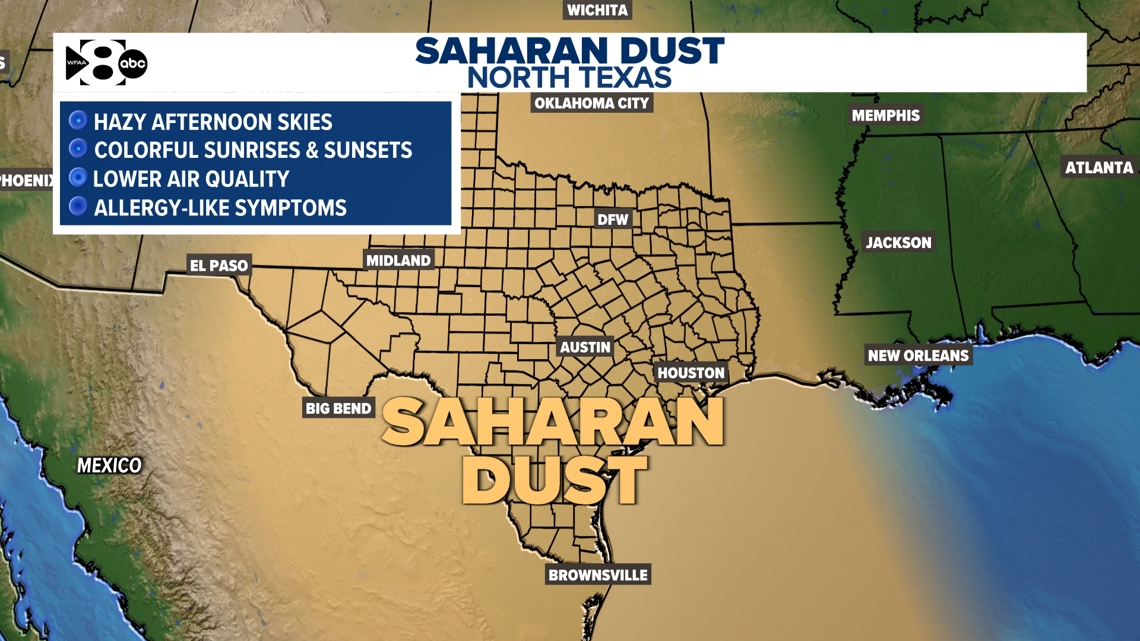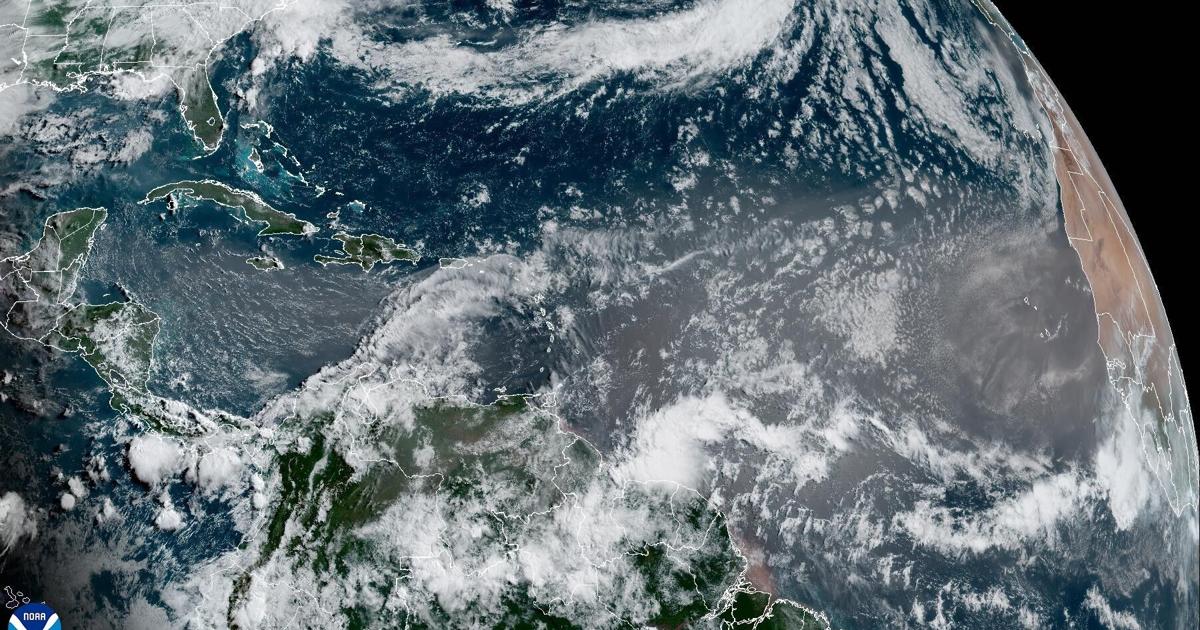North Texas Dust: Saharan Air Mass Impact And What You Need To Know

Welcome to your ultimate source for breaking news, trending updates, and in-depth stories from around the world. Whether it's politics, technology, entertainment, sports, or lifestyle, we bring you real-time updates that keep you informed and ahead of the curve.
Our team works tirelessly to ensure you never miss a moment. From the latest developments in global events to the most talked-about topics on social media, our news platform is designed to deliver accurate and timely information, all in one place.
Stay in the know and join thousands of readers who trust us for reliable, up-to-date content. Explore our expertly curated articles and dive deeper into the stories that matter to you. Visit Best Website now and be part of the conversation. Don't miss out on the headlines that shape our world!
Table of Contents
North Texas Dust: Saharan Air Mass Impact and What You Need to Know
North Texas residents are bracing themselves for another round of hazy skies and reduced air quality, thanks to the intrusion of a Saharan Air Layer (SAL). This massive plume of dust, originating from the Sahara Desert in Africa, regularly travels across the Atlantic, impacting weather patterns and air quality in the southern United States, including the Dallas-Fort Worth metroplex. Understanding the impact of this phenomenon is crucial for protecting your health and preparing for potential disruptions.
What is a Saharan Air Layer (SAL)?
The SAL is a naturally occurring phenomenon. It's a layer of dry, dusty air that forms over the Sahara Desert and is transported westward by strong winds high in the atmosphere. This air mass is incredibly dry, hot, and laden with dust particles, including sand and other mineral aerosols. These particles can significantly reduce air quality and visibility, creating a hazy, orange-tinged sky.
Impact on North Texas:
The arrival of a SAL in North Texas typically brings:
- Reduced Air Quality: The high concentration of dust particles can exacerbate existing respiratory issues like asthma and allergies. Individuals with such conditions should take extra precautions. The Texas Commission on Environmental Quality (TCEQ) regularly monitors air quality and issues alerts when necessary. Check their website () for updates.
- Decreased Visibility: The dust reduces visibility, impacting driving conditions, especially for those traveling on highways or in rural areas. Drivers should exercise caution and reduce speeds.
- Stunning Sunsets: While the reduced air quality isn't ideal, the SAL often produces spectacular sunsets, with vibrant oranges, reds, and purples painting the sky.
- Suppression of Tropical Storm Development: While bringing dust, the SAL can sometimes inhibit the formation and intensification of hurricanes in the Atlantic Ocean. This is because the dry air suppresses the thunderstorms needed for tropical cyclone development.
What You Need to Know & How to Prepare:
- Check Air Quality Reports: Regularly monitor air quality forecasts from the TCEQ. If an air quality alert is issued, limit your time outdoors, especially during peak pollution hours.
- Protect Your Respiratory Health: If you suffer from asthma or other respiratory conditions, keep your inhalers readily available and follow your doctor's advice. Consider wearing a high-quality dust mask if you must spend time outdoors.
- Drive Safely: Reduce your speed and increase your following distance when visibility is reduced. Use your headlights even during the day.
- Stay Hydrated: The dry air associated with the SAL can lead to dehydration. Drink plenty of fluids.
Beyond the Immediate Impact:
The long-term effects of Saharan dust on the environment and climate are still being researched. Studies suggest that the dust can influence cloud formation, ocean fertilization, and even contribute to rainfall patterns in some regions. However, the immediate impact on North Texas residents is primarily focused on air quality and visibility.
In Conclusion:
The Saharan Air Layer’s impact on North Texas is a regular occurrence. By understanding the potential effects and taking appropriate precautions, residents can mitigate the risks and even appreciate the stunning sunsets the dust can create. Remember to check local air quality reports and prioritize your health and safety during periods of high dust concentration. Stay informed and stay safe!

Thank you for visiting our website, your trusted source for the latest updates and in-depth coverage on North Texas Dust: Saharan Air Mass Impact And What You Need To Know. We're committed to keeping you informed with timely and accurate information to meet your curiosity and needs.
If you have any questions, suggestions, or feedback, we'd love to hear from you. Your insights are valuable to us and help us improve to serve you better. Feel free to reach out through our contact page.
Don't forget to bookmark our website and check back regularly for the latest headlines and trending topics. See you next time, and thank you for being part of our growing community!
Featured Posts
-
 Winning Bets Roland Garros Zverev Vs Cobolli And Griekspoor Vs Quinn
May 31, 2025
Winning Bets Roland Garros Zverev Vs Cobolli And Griekspoor Vs Quinn
May 31, 2025 -
 Georgia Powers Forecast Accuracy Debated Amid Unprecedented Data Center Expansion
May 31, 2025
Georgia Powers Forecast Accuracy Debated Amid Unprecedented Data Center Expansion
May 31, 2025 -
 Edmonton Oilers Defeat Dallas Stars In Game 5 Clinch Final Berth
May 31, 2025
Edmonton Oilers Defeat Dallas Stars In Game 5 Clinch Final Berth
May 31, 2025 -
 Saharan Dust Cloud Timing And Forecast For Colorful Louisiana Sunsets
May 31, 2025
Saharan Dust Cloud Timing And Forecast For Colorful Louisiana Sunsets
May 31, 2025 -
 Covid 19s Impact How A Lost Year Affects Texas Basketball Under Sean Miller
May 31, 2025
Covid 19s Impact How A Lost Year Affects Texas Basketball Under Sean Miller
May 31, 2025
